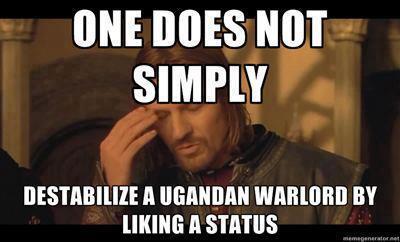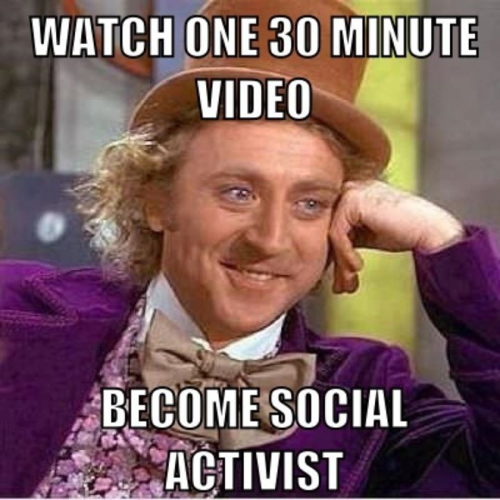
Viral media saw an interesting development last week with Invisible Children’s release of its “Kony 2012” film, which at the time of this writing has garnered well over 75 million views as well as storms of heated criticism. One could practically write entire books on the issues that Invisible Children raises – both intentionally and unintentionally – in this campaign, but for the purposes of this post I want to keep the focus fairly narrow and trained on the actual components of the video that make it successfully viral – and what that potentially indicates about how information regarding especially complex issues is diffused, as well as what difference that form of diffusion makes.
What makes Kony 2012 so powerful? Because regardless of where you come down on the issues raised in the links above, it is undeniably powerful, at least in terms of its primary goal, which was essentially to get people’s attention.
First, it makes direct appeals to the emotions of its viewers. This is not by any means a new tactic; pity has long been a tool of charity work, and is often an effective one. The Kony 2012 video moves past pity and seeks to inspire outrage, hope, and finally a sense of personal empowerment on the part of the viewer, a sense that by watching the video the viewer has already done something important and impactful. This sense of accomplishment and empowerment can be intensified by the sharing of the video and the viewer’s demand that others follow suit. The video presents the ignorance of the developed West as its primary sin and the primary obstacle in the way of Joseph Kony being brought to justice; it therefore implicitly offers the simple fact of “awareness” as a form of blanket solution to this problem, with the supposition that action will necessarily follow. Viewing and sharing the video therefore offer an emotionally powerful but objectively questionable experience: the sense of having taken active part in something both significantly communal and directly world-altering.

This leads me to the second and arguably more important aspect of what made Kony 2012 so successful: In the interest of making its emotion-based appeal, it employs a starkly simple and appealing narrative. This narrative presents an extremely complex, problematic, and history-laden situation as a straightforward tale of good and evil, innocence and wickedness, power and weakness – but not the kind of story about power that it might tell. Invisible Children’s narrative is careful to tread nowhere near accusations of First World privilege or racism, and – again – presents ignorance as the West’s primary sin. The Ugandan government is presented as a lesser protagonist in need of help in capturing Kony rather than as the highly troubling entity that it actually is. Kony’s abducted child soldiers are presented as innocent victims in need of rescue, rather than in terms of their much more problematic statuses as both victims and perpetrators of atrocity – a problem that has hindered return and reconciliation for many. What is perhaps the film’s most revealing moment occurs quite early, when the director shows his five-year-old son a picture of Kony and the survivor Jacob and explains the situation – in a child’s terms. The child responds, “Stop him.” Which is really the entire film in two words, on essentially the level of complexity at which it is delivered.
At this point I want to return to a previous post by Jenny Davis in which she posits that we can understand internet memes as the “mythology of augmented society”. Davis presents four aspects of memes that support this argument:
1) internet memes are simultaneously digital and physical; 2) internet memes are quickly spread and often 3) user generated; 4) internet memes are easily adaptable.
Kony 2012 fits at least two (1 and 2) of these aspects fairly well, though I would concede that it does not quite represent a meme of the type that Davis is discussing. However, much of what makes Kony 2012 powerful arguably falls within Davis’s discussion of memes: it is simultaneously digital and physical, it was quickly spread, and the simplicity of its narrative makes it potentially extremely adaptable. To Davis’s list, then, I would add a 5th aspect that contributes to both speed of diffusion and adaptability: conceptual simplicity. Essentially: the fewer component parts there are to what is being spread, the easier it is to move things around to suit a broad range of uses and the more likely it is that what is being spread will enjoy a broad range of appeal.
Additionally, the simplicity of Kony 2012 contributes to the strength of its ties to “myth” in both cultural and narratological senses. In its story of good vs. evil and its far more implicit narrative of civilized West against barbaric/undeveloped sub-Saharan Africa it is a story that cuts directly to the heart of what middle class white America often still identifies as desirable and valuable, as well as presenting an appealing and compelling (for its intended audience) tale of who white Westerners are and what their “destiny” might be. Although it is not strictly an origin story, it contains aspects of such in its presentation of an innocent and helpless generation of children destroyed by an uncomplexedly wicked man, and the affluent white saviors — their own role uncomplicated by any intrusive Ugandan agency — who will defeat evil and save the innocent.
So Kony 2012’s simplicity is a direct aid in the speed of its dissemination. Other critics have written eloquently on the potential problems that accompany the simplification of a complex situation. Still other critics have written with equal eloquence on the problems inherent in such a simple and mythical narrative’s marginalization of African agency. For me, the questions I want to close with — since as yet I have no satisfactory answers — are these: If simplicity helps to give stories like Kony 2012 memetic power, can any meaningful element of that power be retained without doing violence to the truth of the situation? Can complex narratives also behave virally? Are complexity and this kind of “mythology of an augmented society” necessarily at odds?

Comments 8
Technoagita: Technology, Art, Business » Blog Archive » Viral Charity’s Simple Problem: The case of Kony 2012 » Cyborgology — March 14, 2012
[...] via Viral Charity’s Simple Problem: The case of Kony 2012 » Cyborgology. [...]
Kony 2012: Whiteness, Social Media and Africa :: racismreview.com — March 15, 2012
[...] the video, including that the film gives Ugandans little agency in determining their own destiny. Sarah Wanenchak wonders whether any viral video will necessarily be as overslimplified as this one is. For those that are [...]
#HipsterStudies: Kony, Hipsters, and Social Distinction » Cyborgology — March 15, 2012
[...] First, as Sarah Wanenchek so eloquently argued yesterday, the Kony 2012 movement has been successful largely because it has been spread “virally” via social media like Facebook, Twitter, and Tumblr. The fact that the video has reached over 75 million views in a little over a week plays testament to this fact. However, social media is often treated like a hipster’s playground because it is “new” and “hip” and platforms like Facebook lend themselves nicely to self-promotion and vanity, two things hipsters are said to do quite well. The video below, titled “Future Hipsters,” helps encapsulate this sentiment. [...]
Kony 2012: Whiteness, Social Media and Africa | LA Progressive — March 17, 2012
[...] video, including that the film gives Ugandans little agency in determining their own destiny. Sarah Wanenchak wonders whether any viral video will necessarily be as overslimplified as this one is. For those that are [...]
Martha — March 20, 2012
Wondered whether you might look at the "copyright debate" as an example of how complexity (the law and its philosophies) is indeed at odds with the mythologies of augmented society - if I understand the term correctly. By way of an example here is a comment made by someone on a blog about new copyright act in Canada : Will the public come to accept these increasing restrictions of copyright as just and necessary to protect the rights and livelihoods of creators, or will they see them as intrusive and the avarice of the media industry? - the avarice of industry being the mythology of augmented society since it denies our complicity in the consumption of such media. Anyway wish I could hang out with you all in April - will the discussions be archived?
Kony2012: “A white savior film with social media added in” « Political Activism & Social Media in 2012 — October 10, 2012
[...] controversy and upset many Ugandans, as they feel voiceless while others are telling their story. Sarah Wanenack identifies the central, symbolic moment in the video: “What is perhaps the film’s most [...]
KONY2012 Empowering or Misleading a Facebook Generation? « Political Activism & Social Media in 2012 — October 22, 2012
[...] important, and by sharing the video the sense of accomplishment and empowerment is intensified. Wanenchak states: “The video presents the ignorance of the developed West as its primary sin and the [...]
#Trending Causes: Powerful Or Just Trendy? | Citizen Media — March 11, 2013
[...] and “Bell Lets Talk” day are positive examples of digital activism, there are still many instances where becoming part of a mere viral online trend is mistaken for as a hip act of social [...]